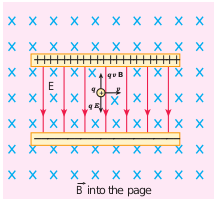Motion of a charged particle under crossed electric and magnetic field (velocity selector)

$$ \vec{E} $$
$$ \vec{B} $$
$$ \vec{v} $$
$$ \vec{F} = q \vec{E} + q \vec{B} \times \vec{v} $$
For a positive charge, the electric force on the charge acts in the downward direction, whereas the Lorentz force acts upwards. When these two forces balance each other, then
$$ qE = qBv $$
$$ v = \frac{E}{B} $$
(3.62)
This principle is used in the Bainbridge mass spectrograph to separate isotopes. This concept is explained in Example (3.21).
Schematic diagram of Bainbridge mass spectrometer
$$ m_2 > m_1 $$
$$ 2r $$
$$ m_2 $$
$$ B $$
$$ S2 $$
$$ S1 $$
$$ m_1 $$
Magnetic field perpendicular to the diagram and into the plane
Beam of positive ions
Vacuum chamber
Note: $$ \Delta d = d_2 - d_1 $$ $$ t_{235} = \frac{97.6 \times 10^{-2}}{5.76 \times 10^{5}} $$ $$ t_{238} = \frac{98.8 \times 10^{-2}}{5.88 \times 10^{5}} $$
This means, for a given magnitude of $$\vec{E}$$-field and $$\vec{B}$$-field, the forces act only on the particle moving with a particular speed $$v_{\text{0}} = \frac{E}{B}$$. This speed is independent of mass and charge.
By proper choice of electric and magnetic fields, the particle with a particular speed can be selected. Such an arrangement of fields is called a velocity selector.
EXAMPLE 3.22
Let $$ E $$ be the electric field of magnitude $$ 6.0 \times 10^6 , \text{N C}^{-1} $$ and $$ B $$ be the magnetic field magnitude $$ 0.83 , \text{T} $$. Suppose an electron is accelerated with a potential of $$ 200 , \text{V} $$, will it show zero deflection? If not, at what potential will it show zero deflection.
Solution:
Electric field, $$ E = 6.0 \times 10^6 , \text{N C}^{-1} $$ and magnetic field, $$ B = 0.83 , \text{T} $$.
$$ v_0 = \frac{E}{B} = \frac{6.0 \times 10^6}{0.83} , \text{m/s} $$
When an electron goes with this velocity, it shows null deflection. Since the accelerating potential is $$ 200 , \text{V} $$, the electron acquires kinetic energy because of this accelerating potential. Hence,
$$ \frac{1}{2} m_e v_{200}^2 = eV $$
Since the mass of the electron, $$ m_e = 9.1 \times 10^{-31} , \text{kg} $$ and charge of an electron, $$ e = -1.6 \times 10^{-19} , \text{C} $$, the velocity acquired by the electron due to the accelerating potential of $$ 200 , \text{V} $$ is
$$ v_{200} = \sqrt{\frac{2 \cdot 1.6 \times 10^{-19} \cdot 200}{9.1 \times 10^{-31}}} , \text{m/s} $$
Since the speed $$ v_{200} > v_0 $$, the electron is deflected towards the direction of the Lorentz force. So, in order to have null deflection, the potential we have to supply is
$$ V = \frac{1}{2} m_e v_{200}^2 = \frac{1}{2} \cdot 9.1 \times 10^{-31} \cdot (148 \times 10^3)^2 $$ $$ V = 65 , \text{V} $$